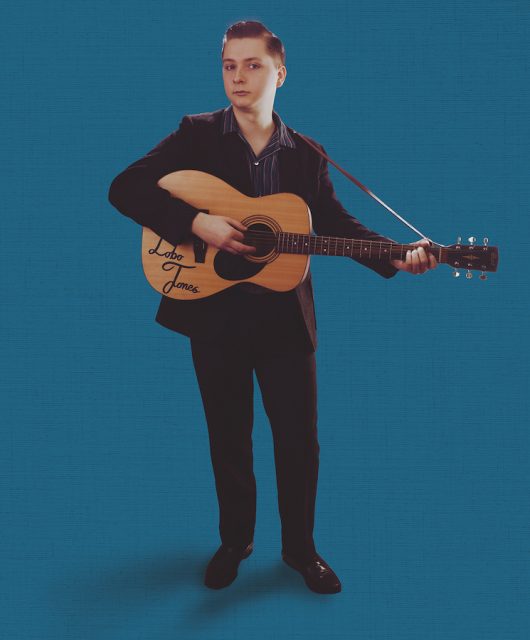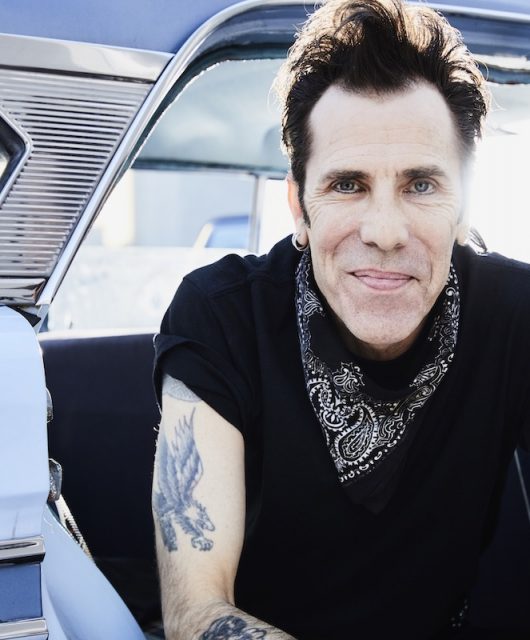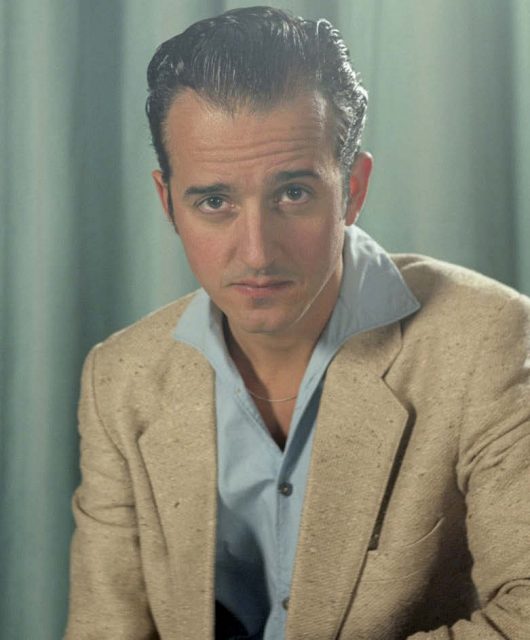We remember Buddy Holly and The Crickets’ classic debut…
I always wondered why they put ‘vocal group with orchestra’ on the record, because we were a rock’n’roll band.” – Jerry Allison
In November 1957 something new arrived on the rock’n’roll scene. The cover of The “Chirping” Crickets, the first album from the rock’n’roll band The Crickets, featured the four members – Buddy Holly, Niki Sullivan, Jerry Allison and Joe Mauldin – smiling and squinting in bright sunlight. They looked incredibly normal. There was no delineated “star”, no “pretty boy” or “wild man” that took centre stage on the cover. Nor did they appear to be a doo-wop vocal group, despite their matching suits. A quick listen to the album demonstrated the dominance of lead vocals, guitar, bass and drums, with backing vocals on a few of the tracks.
Unsuspecting and possibly confused music fans didn’t realise this was a totally new paradigm — the first album by a rock’n’roll band.
In 1957 there were two types of rock’n’roll artists, at least as far as the record companies were concerned. There were solo stars — Elvis Presley, Little Richard, Chuck Berry — and vocal groups — The Drifters, The Coasters, The Midnighters. Some solo acts also credited bands such as Bill Haley And His Comets or Gene Vincent And His Blue Caps, but there was never any doubt who the “star” was on records or on album covers. It was a template rock’n’roll inherited from mainstream pop, geared entirely toward the promotion of solo artists and vocal groups, both of which were routinely backed by professional studio musicians on recordings.
‘Unsuspecting music fans didn’t realise this was a new paradigm — the first album by a rock’n’roll band’
The idea that a small band of four musicians could be the “star” was a radical idea. Many rock’n’roll stars began their careers as members of bands, playing juke joints and honky-tonks, but record companies invariably pushed lead singers to the forefront as “solo” artists. But The Crickets’ road to stardom had been an unusual one, and the decision to de-emphasise the band’s frontman, Buddy Holly, was born of necessity.
Twenty-two months earlier, Holly had signed with Decca Records as a solo artist as record labels scrambled to find another Elvis Presley. After three recording sessions and two unsuccessful singles, Decca executives concluded Holly was not the rock’n’roll star they were looking for. Dropped from Decca in January 1957, he was unsure about his freedom to record for other labels under his own name, and was notified he could not re-record any of the material he recorded for Decca for a period of five years. The moratorium included That’ll Be The Day, a song co-written by Holly and his drummer Jerry Allison that Holly recorded in June 1956 but Decca refused to release.
Despite the legal restriction, Holly and his band re-recorded the song in February 1957 at Norman Petty’s studio in Clovis, New Mexico. Confident of a hit, Petty pitched the song to his friend Murray Deutsch at Peer-Southern Publishing in New York, and Deutsch secured a deal with Bob Thiele of Coral Records to release the song on the Brunswick subsidiary label. Even though Coral and Brunswick were both owned by Decca, it was technically a violation of Holly’s earlier Decca contract to release the song, and the decision was made to credit the single as simply “The Crickets”.
Released by Brunswick on 27 May 1957, That’ll Be The Day first grabbed the attention of radio DJs in Buffalo, New York and Philadelphia, slowly spreading to other regional markets. The success of the single brought attention from Decca’s legal department, and despite the fact that the company was making money from sales of the new version, the label forced financial penalties on Holly in exchange for a full release from his old contract.
‘That’ll Be The Day Would Reach No.1 In The Uk And Sell Over A Million Copies Worldwide’
With Holly completely free to record under his own name, Bob Thiele signed Holly as a “solo” artist to Coral Records and released The Crickets’ recording of Words Of Love under Holly’s name in June 1957. The single garnered attention from a few regional markets but sputtered and failed to chart. Meanwhile, That’ll Be The Day continued its rise, entering Billboard’s Top 100 chart in early August and hitting No.1 pop and No.2 R&B in September. The single would also reach No.1 in the UK and sell over a million copies worldwide in just a few months. Faced with the overwhelming success of the single, Thiele decided to rush a Crickets album into stores.
As the single was conquering the charts, The Crickets were hard at work, appearing on several rock’n’roll multi-artist package shows through the month of August 1957, and then for 10 days at the Brooklyn Paramount Theater in New York as part of the “Alan Freed Holiday Show,” 30 August through 8 September.
As Jerry Allison recalled in a recent interview for Vintage Rock, the first time the group heard of their upcoming album, they were appearing on the Alan Freed show. “The record label didn’t talk to us much, we would just hear from Norman Petty,” Allison said.
With The Crickets in New York, Bob Thiele dispatched a photographer to shoot the album cover on the roof of the Brooklyn Paramount. The rush to release the album led to Allison sporting a less-than-perfect visage on the cover.
“Just before the photo shoot, Niki Sullivan and I got in a scuffle over squirting each other with spray bottles,” Allison recounted. “I had him around the neck, and he said, ‘I give!’ I let him loose and he punched me in my left eye. I told him, ‘I’ll whip your ass later,’ but I didn’t.”
Despite Allison’s swollen eye, the photo session proceeded and the minor injury would become immortalised on one of the landmark albums of rock’n’roll. With the cover complete, Thiele poured through tapes of Crickets recording sessions to compile the tracks for the album. It soon became apparent they needed to record new material to complete the LP.
By that point, The Crickets had departed New York for a 17-week tour with “The Biggest Show Of Stars For ’57” package tour. Studying the map of the tour, Petty noticed The Crickets would be appearing in Oklahoma City on 29 September 1957, a date that coincided with a booking for Petty’s pop combo, The Norman Petty Trio, at the nearby Tinker Air Force Base Officer’s Club.
“We were in the middle of that long tour when Norman called us to Tinker Air Force Base,” Allison told Vintage Rock. “He brought some of his recording equipment and we recorded a few tunes for the album. I know we did the Little Richard song, Send Me Some Lovin’, for Larry, Buddy’s brother, because he wanted us to record that song.”
Released on 27 November 1957, The “Chirping” Crickets opens with the powerful rocker, Oh, Boy!, written by rockabilly artists Sonny West and Bill Tilghman. West originally planned to record the song himself, but Norman Petty pitched Sonny West’s demo recording to The Crickets. After West and Tilghman heard The Crickets’ version, they knew it had the better chance of scoring a hit. Their assessment was right on the money. Released as a single one month before The “Chirping” Crickets album, Oh, Boy! shot to No.10 on the Billboard Top 100 and hit No.3 on the UK chart, bringing in a steady stream of royalties for West and Tilghman for decades.
The rockers continue with Not Fade Away. Recorded on 29 May 1957, just two days after the release of That’ll Be The Day, Not Fade Away demonstrated The Crickets gaining ground with every recording, both creatively and technically. Built around a Bo Diddley beat, the rhythm was driven by Jerry Allison’s drumming on a cardboard box rather than a drum kit and vocal “bop-bops” that were overdubbed by Niki Sullivan and Holly. This unusual arrangement softened the volume of the backbeat while losing none of its excitement, allowing Holly’s vocals and lead guitar work to soar above the mix. Initially released as the B-side of Oh, Boy!, Not Fade Away has since become an essential rock’n’roll classic.
Downshifting to a love ballad, The Crickets delivered a playful take on Roy Orbison and Peanuts Wilson’s tune, You’ve Got Love. Originally written while Wilson was a member of Orbison’s band, The Teen Kings, Wilson recorded a version of the song at Norman Petty’s studio in May 1957. At the time of The Crickets’ Tinker AFB session, Wilson’s version was still unreleased, and Petty suggested the song as a way of getting another track on the album that his publishing company could profit from. Wilson’s original version was eventually released by Brunswick as the B-side of his rockabilly classic, Cast Iron Arm.
Maybe Baby was definitely the standout track from the Tinker AFB session. Inspired by a handful of lyrics written by Holly’s mother, Ella Holley, Buddy completed the song but Mrs Holley refused to accept any credit. The Crickets first recorded the song at the March 1957 session that produced Last Night, but Holly wasn’t happy with the tempo of the recording. After tinkering with the arrangement for several months, they tried it again and nailed a perfect version. In addition to its appearance on The “Chirping” Crickets, Brunswick released it as the A-side of The Crickets’ third single, scoring a No.17 hit on the Billboard Top 100 in March 1958.
The Crickets head back to balladville with the Chuck Willis-penned weeper, It’s Too Late. Originally recorded by Willis in early 1956, the song scored No.3 on the R&B chart, and became a favourite of Holly’s older brother, Larry. The Crickets recorded their version at Petty’s studio in July 1957, closely following the tempo and arrangement of Willis’ original.
To close the first side of the album, Holly and Allison supplied another rocker (with Norman Petty following his usual practice of attaching his name to the credits no matter how small or large his contribution). The jangly masterpiece Tell Me How was recorded at Petty’s studio during the late spring of 1957. The track also appeared on the four-song EP released concurrently with the album, and was paired up with Maybe Baby for The Crickets’ third single. The song was written by Buddy Holly and Jerry Allison, but Holly’s credit was masked by the name “Charles Hardin” (Holly’s legal first and middle name) on copyright records because of uncertainty regarding a publishing contract he signed before starting to work with Norman Petty. The same pseudonym was also used on Not Fade Away and Maybe Baby, all songs Holly wrote in the early months of 1957.
Flipping the record over, Side B kicks off with the hit that transformed The Crickets’ life and fortunes. That’ll Be The Day was inspired by the 1956 John Ford-directed Western epic The Searchers and the film’s bitter anti-hero, Ethan Edwards, as portrayed by John Wayne. Throughout the film, Edwards repeats the phrase “That’ll be the day” to express his contempt for threats. Holly and the rest of The Crickets loved the film, and the phrase became a joking smart-ass catchphrase for the group.
The rockin’ continues with I’m Looking For Someone To Love, the B-side of The Crickets’ debut single and another first class Holly composition. Recorded at the same February 1957 session that produced That’ll Be The Day, The Crickets considered both recordings demos and intended to re-record the songs if they attracted interest from record labels. But Norman Petty believed the recordings stood on their own as master takes, and millions of rock’n’roll fans agreed.
Two ballads from the Tinker AFB session slow the pace down. An Empty Cup (And A Broken Date) was another Roy Orbison song, while the John Marascalco and Leo Price composition, Send Me Some Lovin’ had been a No.54 hit for Little Richard in April 1957. While Holly delivered solid versions of both songs, the final versions were oversweetened by Petty’s extensive overdubbing of background choruses from the vocal group The Picks.
The weeper, Last Night, closes out the trilogy of Side B ballads. Written by Crickets bass player Joe Mauldin for his previous band, The Four Teens, the song features a solid vocal workout by Holly that The Crickets recorded shortly after Mauldin joined the band in March 1957.
The final Tinker AFB recording closes out the album on a high note. Rock Me My Baby was a hot novelty tune by Santa Fe, New Mexico-based songwriter and hillbilly bandleader Shorty Long and his writing partner, Susan Heather. The Crickets delivered a rockin’ performance, featuring a sizzling guitar solo from Holly.
Although The “Chirping” Crickets enjoyed solid sales in the US, it failed to chart. The song made a bigger splash in the UK, eventually reaching No.5 on the albums chart in April 1958, shortly after The Crickets’ first UK tour in March 1958.
Beyond the album sales, the concept of a rock’n’roll band proved enthralling to teenagers on both sides of the Atlantic. The Crickets were not matinée idols or teen dreams. For any would-be, teenaged rock’n’roller, the group looked ordinary, like the friends you went to school with, scuffled with on a Saturday night, or shared off-colour jokes with.
“Roger Cook, who’s a great songwriter, told me one time that when he saw us, he realised you didn’t have to be Elvis Presley to be in a band,” Jerry Allison said. “Paul McCartney told me if it wasn’t for The Crickets there wouldn’t be any Beatles. And when we were inducted into the Rock & Roll Hall Of Fame, Keith Richards said, ‘If it wasn’t for these cats here there wouldn’t be any Rolling Stones.”
The idea that anyone — a tall nerdy looking guy in glasses or even a guy with a swollen eye from a recent fight — could be a rock’n’roll star was revolutionary. All it required was some talent, luck and rock’n’roll cheek. This was especially true for British youth who were emerging from more than a decade of post-war austerity. As Philip Norman wrote in Rave On: The Biography Of Buddy Holly, “As much as anything he sang or played, Buddy’s appearance on The “Chirping” Crickets cover was a revelation. It showed that to play rock’n’roll you did not have to be a bespangled Technicolor freak — you could be turned out conservatively enough to satisfy the most exacting parent, vicar or teacher … he put the music into everyone’s reach.”
Even though Holly’s profile as a “solo” artist would soon eclipse The Crickets, the template of the rock’n’roll band as an artist unto itself was planted in the minds of aspiring teenage musicians. And the power of The “Chirping” Crickets to entertain, excite and inspire generations of rock’n’roll fans has not diminished. Its place as one of the greatest and most iconic rock’n’roll albums remains just as powerful as it was over six decades ago.
Randy Fox







